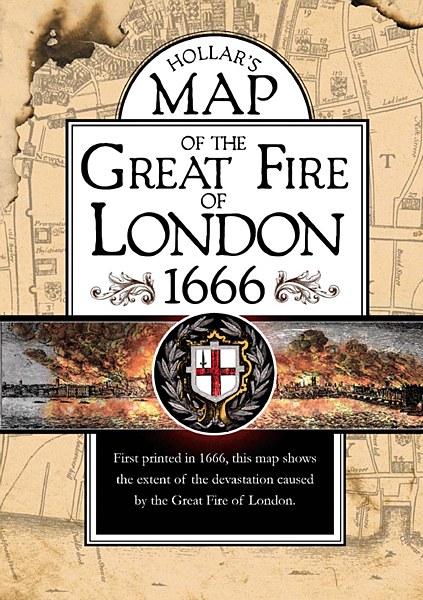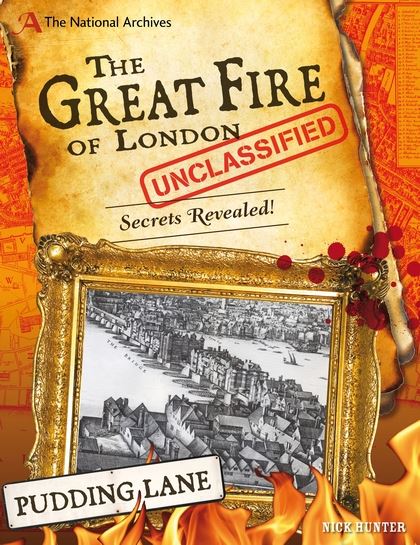Front cover of The Great Fire of London: Unclassified
‘Lord! What sad sight it was by moone-light to see, the whole City almost on fire’ – Samuel Pepys
To this day I can remember singing ‘Ring a Ring o’ Roses’ and ‘London’s Burning’, two of many nursery rhymes I learnt as a child that sounded great in the school playground. I can also remember my father encouraging me up the multitude of steps of the Monument in Pudding Lane, where he enthusiastically pointed out that ‘this is where the great fire of London started, Jane… remember that!’ I didn’t think I was going to – not at the age of six – but hey, I did!
My father’s history lessons were mild brainwashing of historical fact, particularly up those steps, that day! Of course, those nursery rhymes have links to the Great Fire of London and the plague – as you can find out if you decipher them.
There are other ways to take a trip into London and back in time, to tread in the footsteps of Samuel Pepys and become a tourist guide for the day. Take The Great Fire of London – The Essential Guide: it includes first-hand descriptions from the diaries of Samuel Pepys and John Evelyn, as well as a gripping account from renowned historian Adrian Tinniswood. Or, if you want to get a greater sense of the character of Samuel Pepys, his observations and the emotion he felt at that time, consider reading his account of The Great Fire of London.

Hollar’s Map of The Great Fire
Or take Hollar’s Map Of The Great Fire Of London 1666. This will guide you through the old streets as they were then, showing the extent of the devastated areas in the City. This map, commissioned by the Lord Mayor to plan the city’s reconstruction, shows the full extent of the damage, including the streets, churches and livery companies that were destroyed, incorporating the works of Sir Christopher Wren, such as St. Paul’s Cathedral.
Another fascinating read in this era, Pepys’s London, gives an insight into the turbulent, boisterous city as it was, enduring the strains caused by foreign wars, the Great Plague and the Great Fire. The Restoration in 1660 brought the reopening of the theatres, with women, such as Nell Gwyn, appearing on the stage for the first time. The period saw the development of English opera and the first public concerts. Pepys lived through a time of change, in a city of contrasts, which maintained a sophisticated cultural scene, yet was a focus for political turmoil that sometimes spilled over into violence.
Taking a look at a more general view of London in the 1600s, London – The Concise Biography, by historian, novelist and broadcaster Peter Ackroyd, gives a fascinating account of a journey through the city of London, to the times of plague and pestilence, fire and floods, crime and punishment, sex and theatre. He makes us wonder how people used to live and survive, bringing the ever-changing streets alive for the reader.
For children who love history, The National Archives’ The Great Fire of London – Unclassified is ideal. The Great Fire of London destroyed the homes of almost 90% of London’s population. Could it have been prevented? From the outbreak of the fire at a bakery on Pudding Lane, to fire-fighting techniques and meddling Lord Mayors, The Great Fire Unclassified takes readers on a journey back in time to uncover the true story behind London’s most destructive ever fire. Real-life artefacts and documentation enable readers to build a true and real account of the Great Fire and how it shaped Britain today.
But even great disasters can have positive consequences. On 30 April 1665, the diarist Samuel Pepys recorded the first rumours that the bubonic plague was spreading through London: ‘Great fears of the sickness here in the City – God preserve us all!’ Throughout the long summer when the plague was at its worst, Pepys stayed in the city and his diary is one of the most vivid accounts of what became known as the Great Plague. Thought to have come by ship from Amsterdam, which had been ravaged by the disease for two years, the plague reached its height in August and September 1665, when over 7,000 Londoners were dying every week. The disease continued until the Great Fire of London in September 1666. A case of one calamity resolving another.


Edward Hyde, Earl of Clarendon. Mentor and companion to the young Charles II in exile.
Courtiers told Charles that Clarendon had been saying bad things about him. Charles asked what those things were and afterwards said ‘He says worse than that to my face!’
If you want a reasonably honest written portrait of Hyde’s comtemporaries, you just have to read Hyde.
Cromwell: Not Machiavellian, just a Brave, bad man!
Charles I: The best friend, the best person but incapable of taking good advice.
Pepys recounts seeing the ‘Brothers’ (Charles and James) coming towards him and he ducks down an alleyway to avoid them.
Some accounts give Charles and James valiantly fighting the fire of London but different accounts vary.
The ‘Rupert and Monck Letters’ gives a description of the slow deterioration of the Interregnum Navy and the return to dodgy provisions.
John Evelyn’s diary is a good sketch from early to late 1600s. He mentions Isaac Watts and how the scientists of the day were sure that Watts would discover the ‘Philosopher’s stone’!. He also mentions a visit to Leicester in which, the White Horse Inn had a horse trough outside which was the stone coffin of Richard III.
In my, less than humble, opinion, there is no better period in History than the 17th Century.